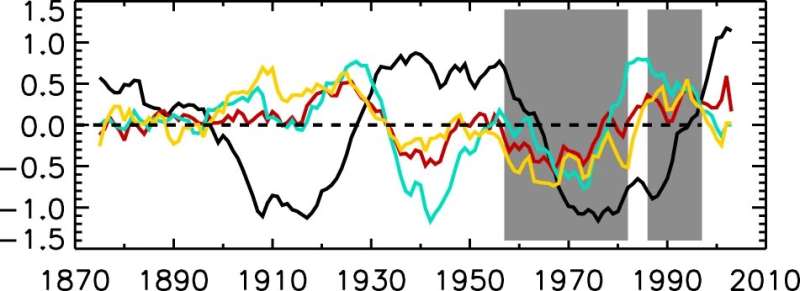This article has been reviewed according to Science X's editorial process and policies. Editors have highlighted the following attributes while ensuring the content's credibility:
fact-checked
proofread
The Baltic sea climate under the influence of the Atlantic: New findings on a 'long distance relationship'

From water temperature to the regional hydrological cycle: the working group Dynamics of Regional Climate Systems at the Leibniz Institute for Baltic Sea Research Warnemünde has recently succeeded, with the help of regional climate models and the statistical analysis of long-term observations, in identifying a strong influence of the Atlantic on the Baltic Sea region behind the signal of climate change.
For this purpose, they investigated the effects of the Atlantic Multidecadal Variability, a periodic variation of the surface water temperature of the North Atlantic, on the Baltic Sea. The results have now been published in npj Climate and Atmospheric Science.
The footprint of human-made global warming is now detectable almost worldwide, even at the regional level. In Northern Europe, for example, the impact of climate change on the cryosphere—which includes all ice-covered areas—is clearly documented. In contrast, the effect on the hydrological cycle is less obvious. So, what can the partially drastic changes, such as precipitation levels in the Baltic Sea region, be attributed to?
Fluctuations in the regional water cycle can be particularly well studied in the Baltic Sea due to its enclosed location, as changes directly affect the salinity. And salinity data from the Baltic Sea have existed since the 19th century. They can therefore provide representative information on the long-term development of precipitation and evaporation in the catchment area.
On this basis, it was shown that the mean salinity of the Baltic Sea is characterized by a fluctuation with a period of about 30 years.
Markus Meier, head of the working group Dynamics of Regional Climate Systems at the IOW, together with a team of authors, has now provided an explanation for this multidecadal variability of the salinity of the Baltic Sea water: the so-called Atlantic Multidecadal Variability (AMV) and its interaction with the North Atlantic Oscillation (NAO) influence the precipitation over the watershed and thus the river inflow into the Baltic Sea: The higher the precipitation, the stronger the river water input.
Both factors lead to a direct dilution of the Baltic Sea water. Mixing processes in the entrance area of the Baltic Sea ensure that the inflowing North Sea water is also diluted—a positive feedback mechanism that further amplifies the multidecadal variation of the salinity.
"With our results, trends caused by climate change can be separated from natural fluctuations. In the future, we will be able to predict changes in salinity over the course of decades," Markus Meier summarizes. "Such predictions could serve sustainable fisheries management, for example, because most fish species are adapted to a specific salinity spectrum. Change leads to stress, and predictions of 'stressful' years would allow early countermeasures."
The influence of AMV is not limited to salinity, however. Florian Börgel, also a scientist in the "Dynamics of Regional Climate Systems" working group at the IOW, investigated how AMV affects the water temperature of the Baltic Sea. He applied for the first time a statistical method to the Baltic Sea, which was originally developed to detect variability patterns in the global ocean. This so-called low-frequency component analysis (LFCA) makes it possible to extract patterns of variability on the scale of several decades from complex data sets.
"We applied LFCA to the sea surface temperature data of the Baltic Sea in the years 1900—2008 and compared the result with the outcome of such an analysis on observational data from the North Atlantic over the same period," explains Florian Börgel.
His conclusion: on the scale of years and decades, the multidecadal variations of sea surface temperatures of the Atlantic correlate very well with those of the Baltic Sea region. However, this picture changes drastically when individual seasons are considered: For winter temperatures only, a considerable fraction of the variations can be attributed to the AMV. Thus, it also plays a special role for the ice cover in the Baltic Sea. In contrast, summer and spring temperatures are not influenced by the Atlantic.
More information: H. E. Markus Meier et al, Multidecadal climate variability dominated past trends in the water balance of the Baltic Sea watershed, npj Climate and Atmospheric Science (2023). DOI: 10.1038/s41612-023-00380-9
Florian Börgel et al, The impact of Atlantic Multidecadal Variability on Baltic Sea temperatures limited to winter, npj Climate and Atmospheric Science (2023). DOI: 10.1038/s41612-023-00373-8
Provided by Leibniz-Institut für Ostseeforschung Warnemünde





















